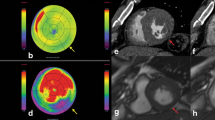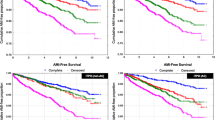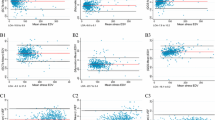Abstract
Left ventricular (LV) wall thickening (WT) assessed from myocardial perfusion (MP) gated SPECT data has been reported to be a marker of functional recovery following myocardial damage. However, the accuracy of WT measurements obtained in the clinical setting rarely has been validated against an independent quantitative reference standard. The purpose of this investigation was to assess the degree to which quantified MP WT agrees with cardiac magnetic resonance (CMR) WT measurements, and to determine whether quantitation is as accurate as visual analysis in detecting abnormal regional WT. MP and ECG-gated True-FISP CMR data were analyzed for 20 patients evaluated after myocardial infarction (age 60 ± 11 years; 95% males). An experienced observer visually graded MP WT on a 5-point scale while viewing MP cines. MP WT was quantified using “Emory Cardiac Toolbox” (ECTb) algorithms. MP algorithms isolated myocardial counts and generated polar maps of WT. CMR data were analyzed by Medis “MASS” software. Manually drawn endocardial and epicardial contours were used to compute WT on CMR. CMR data also were processed for 10 age-matched normal volunteers to define the CMR WT threshold of abnormality. All computations were sampled into conventional 17 ACC/AHA LV wall segments. Receiver operating characteristics (ROC) curve analysis provided discrimination thresholds for optimal accuracy, which subsequently were used to dichotomize the MP methods. WT abnormalities also were assessed for the 3 major arterial territories, and for total numbers of abnormal segments per patient. 25% of all segments had abnormally low WT by CMR. While MP quantitation underestimated CMR WT values for segments with normal WT (26 ± 13% vs. 56 ± 28%, P < 0.0001), measurements were similar for segments with abnormal WT (4 ± 12% vs. 5 ± 9%, P = 0.45). On a segment-by-segment basis, detection of abnormal WT was more accurate by quantitative than visual analysis both for continuous variables (ROC area = 88 ± 2% vs. 80 ± 3%, P < 0.0001) and for dichotomized methods (83% vs. 76%, P = 0.04). Agreement of MP versus CMR for discriminating segments with normal from abnormal WT was significantly better for quantitative than visual analysis (κ = 0.59 vs. 0.40, P < 0.0001), with strongest agreement for left anterior descending artery territories (κ = 0.72). Total numbers of segments with abnormal WT per patient demonstrated significant correlation with CMR (r = 0.83, P < 0.0001). MP quantified LV ejection fractions and volumes also correlated well with CMR (r = 0.87 and 0.90, respectively). Quantified MP WT measurements correlated significantly with CMR values, and discriminated segments with abnormal WT from segments with normal WT more accurately than visual analysis. Therefore, quantification should be performed when analyzing regional WT by scintigraphy.





Similar content being viewed by others
Abbreviations
- Bq:
-
Becquerel
- CAD:
-
Coronary artery disease
- CMR:
-
Cardiac magnetic resonance
- ECTb:
-
Emory Cardiac Toolbox software
- ED:
-
End-diastole
- EF:
-
Ejection fraction
- ES:
-
End-systole
- LV:
-
Left ventricle
- MI:
-
Myocardial infarction
- MP:
-
Myocardial perfusion
- SPECT:
-
Single photon emission computed tomography
- WT:
-
Wall thickening
References
Hoffman EJ, Huang SC, Phelps ME (1979) Quantitation in positron emission computed tomography: I. Effects of object size. J Comput Assist Tomogr 5:391–400
Galt JR, Garcia EV, Robbins WL (1990) Effects of myocardial wall thickness on SPECT quantification. IEEE Trans Med Imaging 9:144–150
Heiba SI, Abdel-Dayem HM, Gould R, Bernaski E, Morlote M, El-Zeftawy H, Ambrose JA (2004) Value of low-dose dobutamine addition to routine dual isotope gated SPECT myocardial imaging in patients with healed myocardial infarction or abnormal wall thickening by echocardiogram. Am J Cardiol 93:300–306
Sotgia B, Sciagra R, Parodi G, Kastrati A, Antoniucci D, Schomig A, Pupi A (2008) Estimate of myocardial salvage in late presentation acute myocardial infarction by comparing functional and perfusion abnormalities in predischarge gated SPECT. Eur J Nucl Med Mol Imaging 35:906–911
Ernande L, Cachin F, Chabrot P, Durel N, Morand D, Boyer L, Maublant J, Lipiecki J (2009) Rest and low-dose dobutamine Tc-99m-mibi gated-SPECT for early prediction of left ventricular remodeling after a first reperfused myocardial infarction. J Nucl Cardiol 16:597–604
DePuey EG, Rozanski A (1995) Using gated technetium-99m-sestamibi SPECT to characterize fixed myocardial defects as infarct or artifact. J Nucl Med 36:952–955
Faber TL, Cooke CD, Folks RD, Vansant JP, Nichols KJ, DePuey EG, Pettigrew RI, Garcia EV (1999) Left ventricular function and perfusion from gated SPECT perfusion images: an integrated method. J Nucl Med 40:650–659
Cooke CD, Garcia EV, Cullom SJ, Faber TL, Pettigrew RI (1994) Determining the accuracy of calculating systolic wall thickening using a fast Fourier transform approximation: a simulation study based on canine and patient data. J Nucl Med 35:1185–1192
Faber TL, Vansant JP, Pettigrew RI, Galt JR, Blais M, Chatzimavroudis G, Cooke CD, Folks RD, Waldrop SM, Gurtler-Krawczynska E, Wittry MD, Garcia EV (2001) Evaluation of left ventricular endocardial volumes and ejection fractions computed from gated perfusion SPECT with magnetic resonance imaging: comparison of two methods. J Nucl Cardiol 8:645–651
Sechtem U, Sommerhoff BA, Markeiwicz W, White RD, Cheitlin MD, Higgins CB (1987) Regional left ventricular wall thickening by magnetic resonance imaging: evaluation in normal persons and patients with global and regional dysfunction. Am J Cardiol 59:145–151
Germano G, Erel J, Lewin H, Kavanagh PB, Berman DS (1997) Automatic quantitation of regional myocardial wall motion and thickening from gated technetium-99m sestamibi myocardial perfusion single-photon emission computed tomography. J Am Coll Cardiol 30:1360–1367
Gunning MG, Anagnostopoulos C, Davies G, Forbat SM, Ell PJ, Underwood SR (1997) Gated technetium-99m-tetrofosmin SPECT and cine MRI to assess left ventricular contraction. J Nucl Med 38:438–442
Sharir T, Berman DS, Waechter PB, Areeda J, Kavanagh PB, Gerlach J, Kang X, Germano G (2001) Quantitative analysis of regional motion and thickening by gated myocardial perfusion SPECT: normal heterogeneity and criteria for abnormality. J Nucl Med 42:1630–1638
Konno M, Morita K, Adachi I, Ito Y, Kohya T, Kitabatake A, Tsukamoto E, Tamaki N (2001) Quantitative analysis of regional wall motion and thickening by quantitative gated SPECT comparison with visual analysis. Clin Nucl Med 26:202–207
Cain PA, Ugander M, Palmer J, Carlsson M, Heiberg E, Arheden H (2005) Quantitative polar representation of left ventricular myocardial perfusion, function and viability using SPECT and cardiac magnetic resonance: initial results. Clin Physiol Funct Imaging 25:215–222
Volpi A, De Vita C, Franzosi MG, Geraci E, Maggioni AP, Mauri F, Negri E, Santoro E, Tavazzi L, Tognoni G (1993) Determinants of 6-month mortality in survivors of myocardial infarction after thrombolysis: results of the GISSI-2 data base. Circulation 88:416–449
Moon JC, Lorenz CH, Francis JM, Smith GC, Pennell DJ (2002) Breath-hold FLASH and FISP cardiovascular MR imaging: left ventricular volume differences and reproducibility. Radiology 223:789–797
Cerqueira MD, Weissman NJ, Dilsizian V, Jacobs AK, Kaul S, Laskey WK, Pennell DJ, Rumberger JA, Ryan T, Verani MS (2002) American Heart Association Writing Group on myocardial segmentation and registration for cardiac imaging. Standardized myocardial segmentation and nomenclature for tomographic imaging of the heart. A statement for healthcare professionals from the Cardiac Imaging Committee of the Council on Clinical Cardiology of the American Heart Association. Int J Cardiovasc Imaging 18:539–542
Holly TA, Abbott BG, Al-Mallah M, Calnon DA, Cohen MC, DiFilippo FP, Ficaro EP, Freeman MR, Hendel RC, Jain D, Leonard SM, Nichols KJ, Polk DM, Soman P (2010) ASNC imaging guidelines for nuclear cardiology procedures. Single photon-emission computed tomography. J Nucl Cardiol. doi:10.1007/s12350-010-9246-y
Landis JR, Koch GG (1977) The measurement of observer agreement for categorical data. Biometrics 33:159–174
Lorenz CH, Walker ES, Morgan VL, Klein SS, Graham TP Jr (1999) Normal human right and left ventricular mass, systolic function, and gender differences by cine magnetic resonance imaging. J Cardiovasc Magn Reson 1:7–21
Mochizuki T, Murase K, Fujiwara Y, Tanada S, Hamamoto K, Tauxe WN (1991) Assessment of systolic thickening with thallium-201 ECG-gated single-photon emission computed tomography: a parameter for local left ventricular function. J Nucl Med 32:1496–1500
Kurihara H, Nakamura S, Hatada K, Takehana K, Hamada S, Watanabe J, Yuyama R, Mimura J, Sugiura T, Iwasaka T (2002) Early prediction of regional functional recovery in reperfused myocardium using single-injection resting quantitative electrocardiographic gated SPET. Eur J Nucl Med 29:458–464
Petretta M, Storto G, Acampa W, Sansone V, Evangelista L, Spinelli L, Cuocolo A (2004) Relation between wall thickening on gated perfusion SPECT and functional recovery after coronary revascularization in patients with previous myocardial infarction. Eur J Nucl Med Mol Imaging 31:1599–1605
Buvat I, Bartlett ML, Kitsiou AN, Dilsizian V, Bacharach SL (1997) A “hybrid” method for measuring myocardial wall thickening from gated PET/SPECT images. J Nucl Med 38:324–329
Nichols K, DePuey EG, Friedman MI, Rozanski A (1998) Do patient data ever exceed the partial volume limit in gated SPECT studies? J Nucl Cardiol 5:484–490
Bartlett ML, Buvat I, Vaquero JJ, Mok D, Dilsizian V, Bacharach SL (1996) Measurement of myocardial wall thickening from PET/SPECT images: comparison of two methods. J Comput Assist Tomogr 20:473–481
Dasan JB, Hadi M, Karthikeyan G, Choudhury S, Thomas EJ, Kumar R, Malhotra A (2004) Reproducibility of regional left ventricular wall thickening obtained by gating resting and redistribution 201Tl myocardial SPECT studies. Nucl Med Commun 25:487–493
Acknowledgments
We wish to thank Brian Becker, CNMT, Barbara Phippen-Nater, CNMT and Jerry Leonardis, CNMT, for their assistance in handling nuclear image data, William Schapiro, RT, and Michael Passick, RT, for assistance in handling CMR data, and Simcha Pollack, PhD, for expert advice in the statistical analysis of data. This work received material support from the Saint Francis Cardiac Research Foundation. Kenneth Nichols and Tracy Faber participate in royalties for the Emory Cardiac Toolbox software. This work was supported by a grant from the Saint Francis Research Foundation.
Author information
Authors and Affiliations
Corresponding author
Rights and permissions
About this article
Cite this article
Nichols, K.J., Van Tosh, A., Wang, Y. et al. Correspondence between gated SPECT and cardiac magnetic resonance quantified myocardial wall thickening. Int J Cardiovasc Imaging 27, 1095–1104 (2011). https://doi.org/10.1007/s10554-010-9746-5
Received:
Accepted:
Published:
Issue Date:
DOI: https://doi.org/10.1007/s10554-010-9746-5




